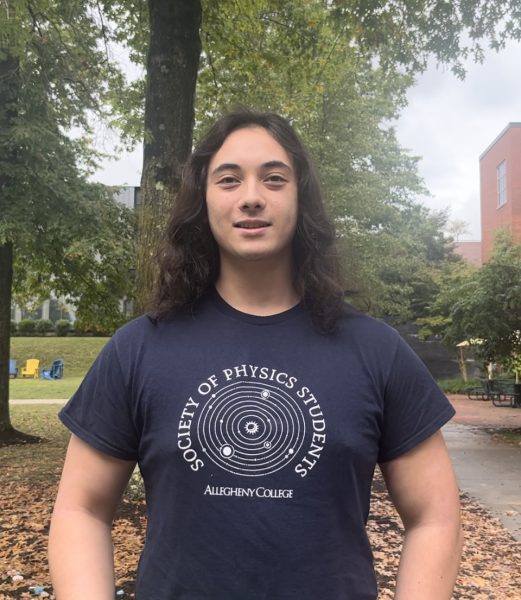Artwork with a hidden complexity
Combining specialties, digital art and math

Kenyon College Professor Judy Holdener presents her most recently finished piece on Sept. 7, 2017 in Quigley Auditorium.
Judy Holdener, of Kenyon college, recently visited Allegheny College to give remarks on the immersion between digital art and mathematics.
Holdener is currently a professor in the field of mathematics, at Kenyon College. Her primary field of focus is number theory, a field with a devoted focus on the properties and relationships of numbers. Although the fundamental core of her career is marked by mathematics, she also holds great interest in the abstruse field of Art. Earning an undergraduate degree from Kent State- followed by a masters and a PhD from University of Illinois. Studying mathematics and art at these prestigious institutions created a foundation for her future career.
At the beginning of the presentation, Holdener displayed a stunning piece, her most recently completed work, which balanced both white and black in a perfect ratio. She explained in depth the process in creating such a symmetrical, aesthetically pleasing piece. It was not simply the result of trial and error, but rather a complex sequence of algorithms, graphs, and use of mathematical theory. The primary technological networks used to create these masterpieces are: adobe illustrator, and photoshop. Adobe illustrator provides a premise to create the patterns, while photoshop allows the user to warp the image to whatever extent the user feels to be best fit. At first, these technological frameworks were unfamiliar to Holdener, so she taught herself through trial and error. She even attended a class at Kenyon, asking a colleague questions when it was needed.
In further discussion Holdener describes the mathematical conglomerates used in creation of her work. She sets up two central points of the formulation: the first Vernacular, and the second mathematical. In the first, she references the array of formulas and fields of mathematics which are present in her art. Juxtaposingly, the second references theories and other baselines seen in her work. Abstract Algebra quantifies the symmetry in her work, while associating positive and negative divergences with white and black allow the piece to come to fruition. In fact, the balance between black and white, although mathematical, is primarily the result of personal choice, or “eyeballing”. She then noted the fundamental region, a tile in the piece that can be repeated over and over again with the same pattern, making the work applicable to everyday life. Relaying that the patterns created are similar to those of tile, or wallpaper- creating a domestic use. Many of the patterns she founded, are ones seen in everyday life.
Her work in the immersion of mathematics and digital art are seen to her as an outlet to avoid everyday strain and boredom. At one point she decided that it was a necessity to visualize sources, synchs, and vector fields; instead of grading linear algebra exams. This then lead to the creation of three prominent patterns in her work. Her intricate masterpieces take two weeks to create, each containing an array of mathematical algorithms and use of theory. One prominent theory in her work is the Thue-Morse theory, branched with its relation to differential geometry. It pertains to a sequence of numbers and patterns, explained to the audience in an interactive manner. Referencing the von Koch Curve in her work she furthers the development of intricacy in each piece .
This seemingly unusual combination of mathematics and Art, is not truly as unconventional as it seems, with Holdener stating “Mathematics are like artists”. She believes there to be a natural link between the two fields, teaching a class on the link titled “Math in the Studio”. In the class students focus on mathematical aspects that create unique patterns and then create their own form of atypical artwork. Formerly, students used their patterns to create a sheet of elaborate wall paper, leading up to them attending a workshop in making wall paper. Astoundingly, the world of mathematics is ever present in everyday work, yet is unrecognized at times.
Holdener said she finds inspiration in famous artist MC Escher, as well as any form of surrealism. In the past she found joy in hands on art and only recently connected her two respected fields of interest. The process for her has just begun, stating that she hopes to expand her line of artwork, working with color in her present work. The multitude of algorithms, theory, and intricacy in her work is an astounding monumental stride.





